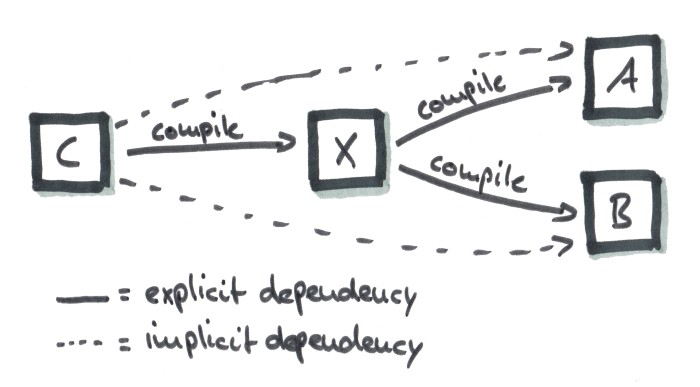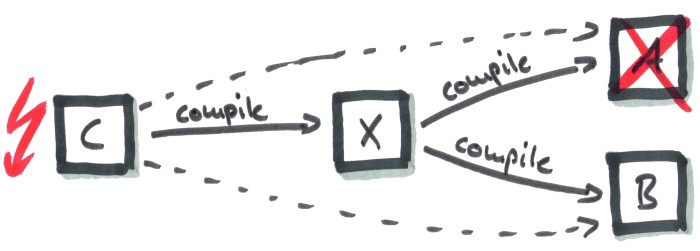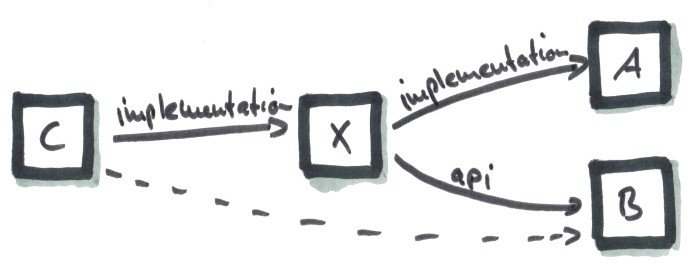Remember the days when we had to manually download every single JAR file that our project needed to run? And not only the JAR files we directly depended upon, mind you, but even those JAR files that our dependencies and our dependencies' dependencies needed to work!
Luckily, those days are over. Today, build tools like Maven and Gradle take care of resolving our dependencies. They do this following the rules of scopes and configurations that we put into the build script.
This has a downside, however. Years ago, when we downloaded each of the direct and transitive dependencies manually, we could decide for each of those dependencies if we really needed it for our project to compile and run. Today, we pay less attention to specifying the correct scopes or configurations, which often results in too many dependencies being available at compile time.
What’s Dependency Pollution?
Say we have a project X. It depends on libraries A and B. And C is a consumer of project X.

C has a transitive dependency to A and B because X needs A and B to function.
Now, imagine these dependencies are available at compile time, meaning
- X can use classes of A and B in its code, and
- C can use classes of X, A, and B in its code.
The dependencies of X leak into the compile-time classpath of C. This is what I’ll call “dependency pollution”.
Why are we only talking about compile-time dependencies?
This article only discusses the problems of too many compile-time dependencies and not those of too many runtime dependencies.
An unwanted compile-time dependency is more invasive because it allows binding the consumer's code to an external project, which may cause the problems discussed below.
An unwanted runtime dependency, on the other hand, will probably only bloat our final build artifact with a JAR file that we don't need (yes, there are scenarios in which a wrong runtime dependency can cause problems, but these are a completely different type of problem).
Problems of Dependency Pollution
Let’s talk about the implications of polluting the compile time of consumers with transitive dependencies.
Accidental Dependencies
The first problem that can easily occur is that of an accidental compile-time dependency.
For instance, the developer of C may decide to use some classes of library A in her code. She may not be aware that A is actually a dependency of X and not a dependency of C itself, and the IDE will happily provide her those classes to the classpath.
Now, the developers of X decide that with the next version of X, they no longer need library A. They sell this as a minor update that is completely backward-compatible because they haven’t changed the API of X at all.

When the developer of C updates to this next version of X, she will get compile errors even though the update of X has been backward-compatible because the classes of A are no longer available. And she hasn’t even changed a single line of code.
Fact is, if we propagate our compile-time dependencies to our consumer’s compile time, the consumer may accidentally create compile-time dependencies she doesn’t really want to have. And she has to change her code if some other project changes its dependencies.
She loses control over her code.
Unnecessary Recompiles
Now, imagine that A, B, C, and X are modules within our own project.
Every time there is a change in the code of module A or B, module C has to be recompiled, even when module C doesn’t even use the code of A or B.
This is again because, through X, C has a transitive compile-time dependency to A and B. And the build tools happily (and rightly) recompile all consumers of a module that was modified.
This may not be an issue if the modules in a project are rather static. But if they are modified more often, this leads to unnecessarily long build times.
Unnecessary Reasons to Change
The problems discussed above boil down to a violation of the Single Responsibility Principle (SRP), which, freely interpreted, says that a module should have only one reason to change.
Let’s interpret the SRP so that the one reason to change a module should be a change in the requirements of that module.
As we have seen above, however, we might have to modify the code of C even if the requirements of C haven’t changed a bit. Instead, we have given control over to the developers of A and B. If they change something in their code, we have to follow suit.
If a module only has one reason to change, we keep control of our own code. With transitive compile-time dependencies, we lose that control.
Gradle’s Solution
What support do today’s build tools offer to avoid unwanted transitive compile-time dependencies?
With Maven,
sadly, we have exactly the case outlined above. Every dependency in the compile scope
is copied to the compile scope of the downstream consumer.
With Gradle, however, we have more control over dependencies, allowing us to reduce dependency pollution.
Use the implementation Configuration
The solution Gradle offers is fairly easy. If we have a compile-time dependency, we add it
to the implementation configuration
instead of the compile configuration (which has been deprecated in favor of implementation for
some time now).

So, if the dependency of X to A is declared to the implementation configuration, C no longer
has a transitive compile-time dependency to A. C can no longer accidentally use classes of A.
If C needs to use classes of A, we have to declare the dependency to A explicitly.
If we do want to expose a certain dependency as a compile-time dependency, for example, if X uses
classes of B as part of its API, we have the
option to use the api configuration instead.
Migrate from compile to implementation
If a module you’re developing is still using the deprecated compile
configuration, consider it a service to your consumers to migrate to the newer implementation
configuration. It will reduce pollution to your consumers' compile-time classpath.
However, make sure to notify your consumers of the change, because they might have used some classes from your dependencies. Don’t sell it as a backward-compatible update, because it will be a breaking change at least for some.
The consumers will have to check if their modules still compile after the change. If they don’t, they were using a transitive dependency that is no longer available and they have to declare that dependency themselves (or get rid of it, if it wasn’t intentional).
Conclusion
If we leak our dependencies into our consumers' compile-time classpath, they may lose control over their code.
Keeping transitive dependencies in check so that they don’t pollute consumer compile-time classpaths seems like
a daunting task, but it’s fairly easy to do with Gradle’s implementation configuration.



